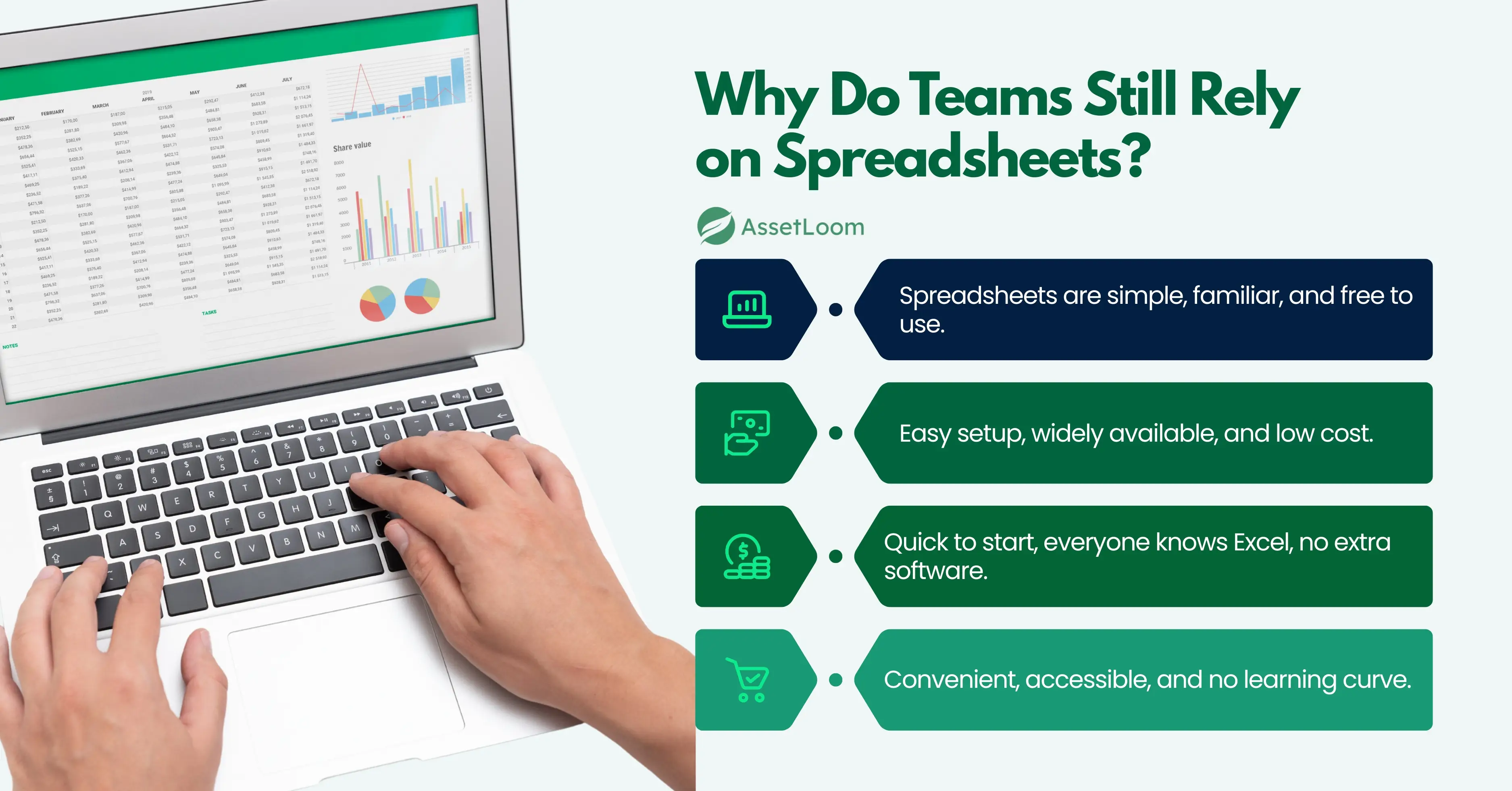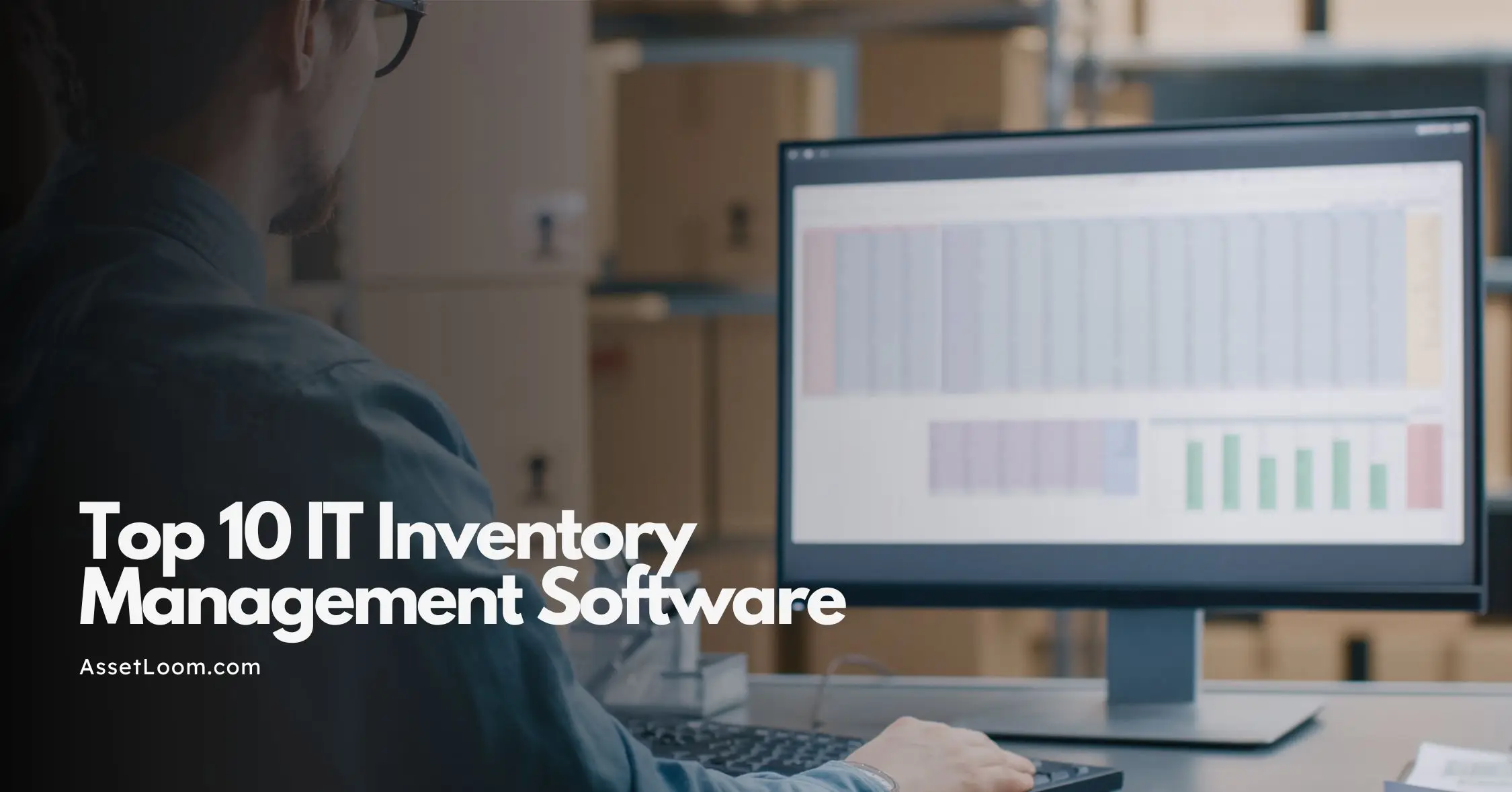Reconsidering Asset Tracking Spreadsheets: Are They Still Worth It?
Still using spreadsheets to track assets? Discover why they fall short long term, the risks they pose, and what modern asset tracking systems offer instead.
Spreadsheets have been around for decades, originally designed to mimic paper accounting worksheets. Over time, they became a familiar tool for everything from budgeting to inventory. Many businesses still rely on them to track IT equipment, office supplies, or other assets. That’s mostly because they’re easy to access, flexible, and already part of daily workflows.
But just because something is familiar doesn’t mean it’s still the right tool. As asset lists grow and responsibilities shift across teams, spreadsheets start to show their limits. They are prone to errors, difficult to scale, and harder to manage as more people get involved.
So the question is: are spreadsheets still a good choice for asset tracking, or is it time to reconsider?
Are Spreadsheets Still the Best Way to Track Assets?
Spreadsheets work well at the beginning. If a team only needs to track a small number of items and a single person manages the file, it seems efficient enough. A few columns for asset names, purchase dates, and serial numbers can cover the basics. Excel and similar tools are already installed on most devices, so there’s no setup or training needed. And when asset data is limited, it’s easy to scroll through and make changes.
But as time goes on, most teams add more items, more details, and more people to the process. What starts as a clean sheet becomes harder to maintain. Sorting through hundreds or thousands of rows to find a single asset becomes a daily frustration. Mistakes begin to creep in. And when more than one person edits the file, it becomes nearly impossible to track what changed and when.
At a certain point, spreadsheets stop saving time and start creating problems. The question shifts from “Can this work?” to “Is this still working as well as it should?”
Why Do Teams Still Rely on Spreadsheets?
Spreadsheets are familiar. Most people in finance, operations, or IT have used them for years, and that comfort level makes them a default choice. There’s no learning curve, no additional cost, and no need to get buy-in from other departments. If a template is available, teams can get started right away.
For small teams or limited assets, spreadsheets feel manageable. A simple list seems better than nothing, and for a while, it is. Teams can add columns as needed, make quick edits, and format the sheet however they want. When budgets are tight or software approvals take time, sticking with Excel may seem like the most practical option.

The problem is that short-term convenience hides long-term issues. What feels fast and flexible in the beginning often turns into hours of manual updates, unclear data, and growing risk as the business scales. But until the problems become obvious, many teams keep using spreadsheets because they’re already in place.
What Problems Show Up When Spreadsheets Are Used Long Term?
The longer a team uses spreadsheets for asset tracking, the more the cracks start to show. What started as a quick solution becomes harder to manage with each new asset, department, or contributor added to the list.
Manual updates take too much time
Every asset has multiple details to track, such as serial numbers, purchase dates, warranty info, assigned user, and location. In a spreadsheet, each of these must be entered by hand, one row at a time. When something changes, someone has to find the right row, update the right cell, and make sure nothing else is affected in the process.
This might seem manageable at first, but it does not scale well. As the number of assets grows, so does the time spent maintaining the file. What should take a few clicks ends up requiring hours of manual work every week. That time adds up, and it usually falls on people whose time could be better spent elsewhere.
There’s no control over what gets changed
Anyone with access to the spreadsheet can edit values, delete rows, or alter formulas, whether intentionally or by accident. Since spreadsheets do not have built-in controls for user permissions or version tracking, it is difficult to know who made changes or when those changes happened.
This lack of control can lead to accidental data loss or errors that go unnoticed until it is too late. Without clear accountability, teams often spend time trying to fix problems caused by unintended edits instead of focusing on their main work.
Errors are hard to catch
Spreadsheets do not alert users when fields are left blank, values are mistyped, or formulas break. A single incorrect entry can lead to wrong calculations or reports that are inaccurate. These errors often go unnoticed until they cause bigger problems, such as failed audits or financial discrepancies.
Automatic checks or validations are usually missing, making it easy for mistakes to slip through and remain hidden in the data. This reduces confidence in the accuracy of the entire asset tracking system.
The file becomes too large and cluttered
Over time, teams add columns for tags, conditions, locations, assigned users, and more. What started as a simple list turns into a dense grid of information that is difficult to read or search through.
As the spreadsheet grows, it becomes slower to open and harder to manage. Finding the right information takes longer, which can lead to mistakes or delays in updating asset records.
There’s no audit trail
When changes are made or assets are moved, it is difficult to track who made the update and when. Spreadsheets do not keep a clear record of these actions.
This lack of history makes it hard to verify the accuracy of asset data or resolve discrepancies. It can also cause problems during audits or when multiple people need to access and update the information.
Read also: Spreadsheets Break Down at Scale,IT Asset Software Doesn’t
What Are the Hidden Costs of Sticking With Spreadsheets?
At first glance, spreadsheets seem free and easy to use. But the real costs often show up later in less obvious ways.
Time costs add up quickly. Employees spend hours updating, searching, and fixing spreadsheet data instead of focusing on higher-value tasks.
Financial risks increase. Errors in asset tracking can lead to inaccurate depreciation calculations, missed tax deductions, or compliance penalties.
Productivity costs emerge from limited collaboration. When only one person can edit the file at a time, delays happen, and teams lose valuable time waiting for updates.
Data quality issues create decision-making costs. Inaccurate or outdated asset information can lead to poor budgeting, planning mistakes, or missed opportunities to optimize resources.
Transition costs grow over time. The longer teams rely on spreadsheets, the more complicated and expensive it becomes to switch to a dedicated asset tracking system later.
These hidden costs often outweigh the upfront savings from sticking with spreadsheets. Investing in a proper asset tracking solution can help avoid these expenses and improve overall efficiency.
When Is It Time to Move On From Spreadsheets?
Knowing when to switch from spreadsheets to dedicated IT asset tracking software can save your team time and money. A 2024 study published in Frontiers of Computer Science found that 94 percent of business spreadsheets contain critical errors. These mistakes pose serious risks, including financial losses, pricing mistakes, and operational problems. Source: Frontiers of Computer Science.
If your team spends hours manually updating asset records or struggles with errors that cause costly setbacks, spreadsheets are holding you back. Collaboration suffers when only one person can edit the file at a time, causing delays and frustration.
As asset inventories grow larger and more complex, spreadsheets become cumbersome and error-prone. When generating reports is a challenge or tracking changes lacks transparency, it is time to consider a dedicated asset tracking system.
While moving away from spreadsheets requires effort, investing in specialized software pays off by reducing errors, saving time, and improving decision-making accuracy.
What Does a Modern Asset Tracking System Offer Instead?
Modern asset tracking systems offer features designed to handle growing asset inventories more efficiently and accurately than spreadsheets.
Real-Time Multi-User Access and Collaboration
Description: Multiple users can access and update asset records simultaneously, eliminating delays and version conflicts. Example: During a physical inventory check, several warehouse managers update equipment statuses at the same time through a cloud platform. This prevents the problem spreadsheets have, where only one user can edit at a time, often causing delays or lost updates.
Automated Audit Trails
Description: Every change to asset data is recorded with details about who made the change and when, improving accountability and tracking. Example: When a laptop is transferred between departments, the system logs that Sarah moved it on June 1st. This audit trail helps quickly resolve discrepancies, unlike spreadsheets where tracking changes requires manual version control.
Mobile Data Capture
Description: Use of mobile devices and barcode or QR scanners allows instant updating of asset information in the field. Example: A technician scans a barcode on a printer using a mobile app to update its maintenance status immediately. In contrast, spreadsheets require data entry after returning to a computer, increasing delay and error risk.
Automated Notifications and Alerts
Description: The system automatically sends reminders for important asset events like maintenance, warranty expiry, or lease renewals. Example: An email alert notifies the IT team when a server’s warranty will expire in 30 days, preventing unexpected downtime. Spreadsheets lack built-in alert features and require manual monitoring.
Dynamic Data Validation and Rules Enforcement
Description: Built-in rules prevent incorrect or incomplete data entry, ensuring data integrity. Example: The system blocks entry of a future purchase date for an asset, reducing data errors. Spreadsheets rely on manual validation rules, which users can bypass easily.
Powerful, Customizable Reporting and Dashboards
Description: Quickly generate detailed and tailored reports on asset status, depreciation, and lifecycle metrics without complex formulas. Example: The finance team creates a depreciation report filtered by department within minutes. In spreadsheets, such reports require manual formula setup and are prone to errors.
Integration with Enterprise Systems
Description: Connects seamlessly with accounting, ERP, or maintenance software to synchronize asset data automatically. Example: Asset values and depreciation data automatically update in the company’s accounting system, eliminating the need for manual exports and imports required by spreadsheets.
Role-Based Security Controls
Description: Restricts access to sensitive asset information based on user roles, protecting data integrity and confidentiality. Example: Only the finance department can view cost and depreciation data, while the facilities team can update location details but cannot see financials. Shared spreadsheets lack this level of access control.
Scalability for Large Data Volumes and Complex Workflows
Description: Efficiently manages thousands of assets and supports various asset types and workflows without performance issues. Example: A global company tracks over 10,000 assets, including IT equipment, vehicles, and machinery across multiple locations. Large spreadsheets tend to slow down or crash under such volume.
What Should You Do Next?
If you are currently using spreadsheets to track assets and find yourself facing challenges like errors, slow updates, or lack of visibility, it’s time to consider upgrading to a modern asset tracking system.
Evaluate Your Current Process
Take a close look at how your asset tracking is working now. Identify pain points like data errors, time spent on manual updates, and difficulty generating reports. If your team frequently spends hours searching for misplaced assets or correcting spreadsheet mistakes, this is a clear sign your current method is inefficient.
Research Asset Tracking Software Options
Explore software solutions designed specifically for asset management. Look for features like cloud access, mobile data capture, audit trails, and integrations with other business systems. Software like Asset Panda, Snipe-IT, or EZOfficeInventory offers customizable platforms that scale with your business and reduce manual work.
Read also: 5 Signs You Finally Have a Good Laptop Asset Tracking System.
Start Small with a Pilot Program
Before fully committing, try a free trial or pilot with a small asset category or team to test the software’s usability and impact on your workflows. Pilot an asset tracking system in your IT department first to manage laptops and peripherals, then expand once you see improved accuracy and efficiency.
Plan for Data Migration
Organize and clean your current spreadsheet data before importing it into the new system to ensure accuracy from day one. Remove duplicate entries, correct inconsistent data formats, and verify key asset details before uploading to avoid importing errors.
Train Your Team
Ensure all users understand how to use the new system and the benefits it brings to daily operations. Provide training sessions and support resources. Hold workshops and create user guides for your staff, so they feel confident scanning barcodes and updating asset information via mobile apps.
Monitor and Optimize
Track how the new system improves your asset management processes and gather user feedback for continuous improvement. Use built-in reporting tools to measure reductions in errors, time savings, and improved audit compliance over the first few months.
Conclusion
Spreadsheets may have served as a simple starting point for asset tracking, but their limitations become clear as your business grows. The high risk of errors, time-consuming manual updates, and lack of audit controls make them a risky choice for managing valuable assets over the long term. Modern asset tracking systems offer more accuracy, efficiency, and control, helping teams stay organized and make better decisions. If you’re experiencing challenges with spreadsheets, it’s worth exploring dedicated software solutions that can scale with your needs and save time and costs in the process. Moving to a modern asset tracking system can help your organization work smarter and protect its investments more effectively.

Related Blogs
Subscribe for Expert Tips and Updates
Receive the latest news from AssetLoom. right in your inbox

